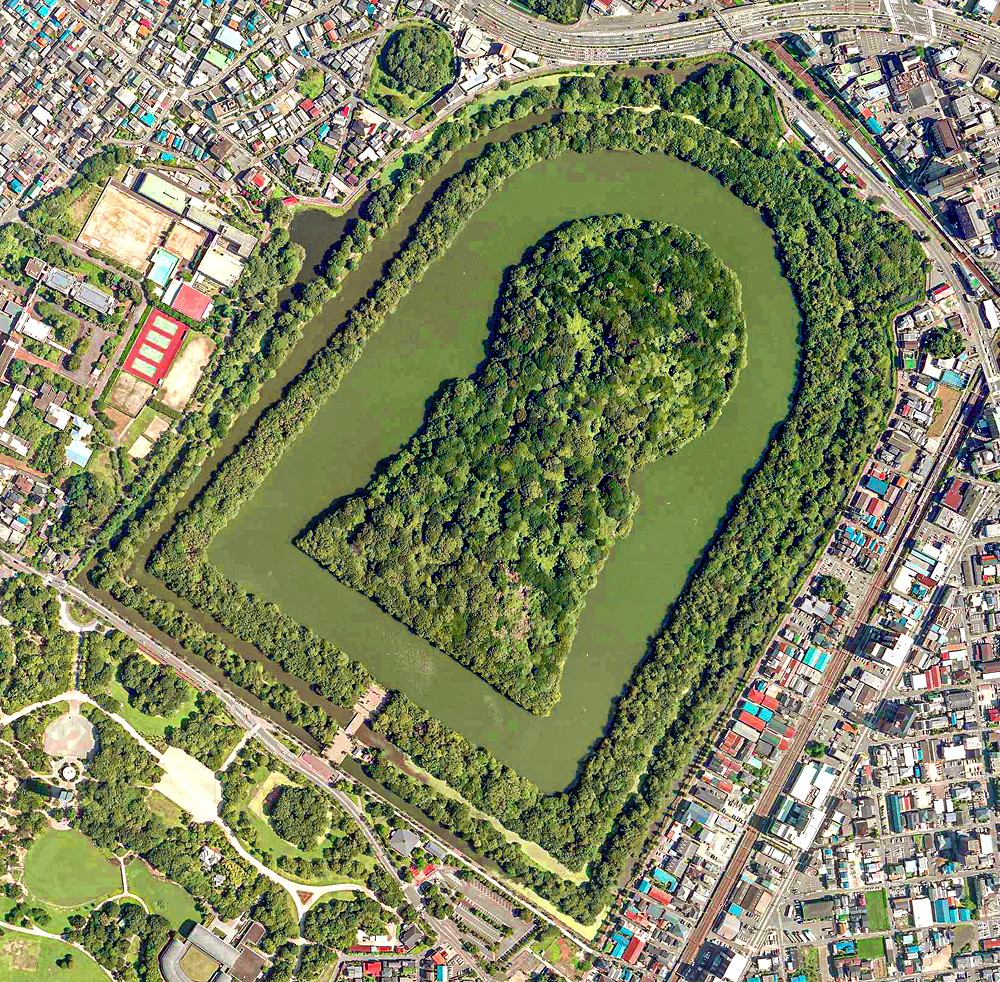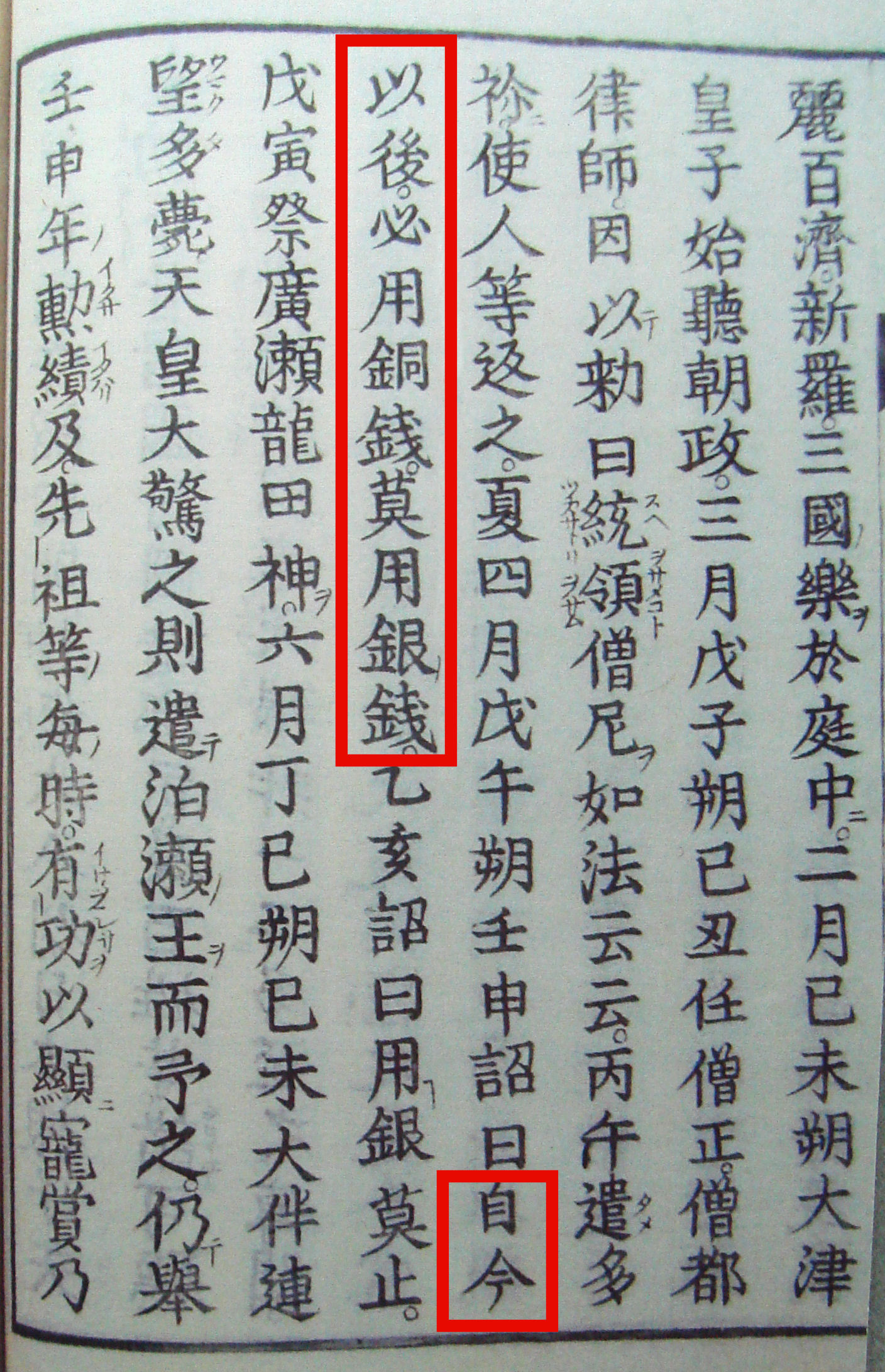|
Emperor Nintoku
, also known as was the 16th Emperor of Japan, according to the traditional order of succession. Due to his reputation for goodness derived from depictions in the Kojiki and Nihon Shoki, he is sometimes referred to as the . While his existence is generally accepted as fact, no firm dates can be assigned to Nintoku's life or reign. He is traditionally considered to have reigned from 313 to 399, although these dates are doubted by scholars. Legendary narrative The Japanese have traditionally accepted Nintoku's historical existence, and a mausoleum (''misasagi'') for Nintoku is currently maintained. The following information available is taken from the pseudo-historical ''Kojiki'' and ''Nihon Shoki'', which are collectively known as or ''Japanese chronicles''. These chronicles include legends and myths, as well as potential historical facts that have since been exaggerated and/or distorted over time. The ''Kiki'' states that Nintoku was born to Nakatsuhime no Mikoto (仲姫命) ... [...More Info...] [...Related Items...] OR: [Wikipedia] [Google] [Baidu] |
Emperor Of Japan
The emperor of Japan is the hereditary monarch and head of state of Japan. The emperor is defined by the Constitution of Japan as the symbol of the Japanese state and the unity of the Japanese people, his position deriving from "the will of the people with whom resides sovereign power". The Imperial Household Law governs the line of Succession to the Japanese throne, imperial succession. Pursuant to his constitutional role as a national symbol, and in accordance with rulings by the Supreme Court of Japan, the emperor is personally sovereign immunity, immune from prosecution. By virtue of his position as the head of the Imperial House of Japan, Imperial House, the emperor is also recognized as the head of the Shinto religion, which holds him to be the direct descendant of the sun goddess Amaterasu. According to tradition, the office of emperor was created in the 7th century BC, but the first historically verifiable emperors appear around the 5th or 6th centuries Anno Domini, AD ... [...More Info...] [...Related Items...] OR: [Wikipedia] [Google] [Baidu] |
Emperor Tenmu
was the 40th Emperor of Japan,Imperial Household Agency (''Kunaichō'') 天武天皇 (40) retrieved 2013-8-22. according to the traditional order of succession. Ponsonby-Fane, Richard. (1959). ''The Imperial House of Japan'', p. 53. He ascended to the throne following the Jinshin War, during which his army defeated that of Emperor Kōbun. Tenmu reigned from 673 until his death in 686, amid Hakuhō period or the late Asuka period. During his reign, Tenmu implemented political and military reforms, consolidating imperial power and centralizing governance. His foreign policy favored the Korean kingdom of Silla while severing diplomatic relations with the Tang dynasty of China. He used religious structures to bolster the imperial authority, building several Buddhist temples including Yakushi-ji and monasteries as well as strengthening ties with the Ise Shrine. He was succeeded by his wife, Empress Jitō. Tenmu is the first monarch of Japan contemporaneously documented as us ... [...More Info...] [...Related Items...] OR: [Wikipedia] [Google] [Baidu] |
Emperor Yūryaku
(417/18 – 479) was the 21st Emperor of Japan, according to the traditional order of succession. According to the ''Kojiki'', this Emperor is said to have ruled from the Thirteenth Day of the Eleventh Month of 456 ( Heishin) until his death on the Seventh Day of the Eight Month of 479 ( Kibi). He is the first archaeologically verifiable Japanese emperor. Protohistoric narrative The Japanese have traditionally accepted this sovereign's historical existence, and a mausoleum (misasagi) for Yūryaku is currently maintained. The following information available is taken from the pseudo-historical ''Kojiki'' and ''Nihon Shoki'', which are collectively known as or ''Japanese chronicles''. These chronicles include legends and myths, as well as potential historical facts that have since been exaggerated and/or distorted over time. It is recorded in the ''Kiki'' that Yūryaku was born to sometime in 417 or 418 AD, and was given the name . As the fifth and youngest son of Emperor Ingy� ... [...More Info...] [...Related Items...] OR: [Wikipedia] [Google] [Baidu] |
Kusaka No Hatabi No Hime
Kusaka no Hatabi no hime (? – after 457) was Empress of Japan as the consort of Emperor Yūryaku. Anston, W.G. (1896). Transactions and Proceedings of The Japan Society, London. Supplement I. Nihongi: Chronicles of Japan from the Earliest Times to A.D. 697. Vol. 1. London: Kegan Paul, Trench, Trüber, & Co. She was the daughter of Emperor Nintoku , also known as was the 16th Emperor of Japan, according to the traditional order of succession. Due to his reputation for goodness derived from depictions in the Kojiki and Nihon Shoki, he is sometimes referred to as the . While his existence .... Notes Japanese empresses consort Year of death missing Daughters of Japanese emperors 5th-century Japanese women 5th-century Japanese people {{Japan-royal-stub ... [...More Info...] [...Related Items...] OR: [Wikipedia] [Google] [Baidu] |
Kōkyū
is the section of a Japanese Imperial Palace called the where the Imperial Family and court ladies lived. Many cultured women gathered as wives of Emperors, and court ladies, as well as the maids for these women; court officials often visited these women for influence, literary charm, or romances. Significant contributions to the literature of Japan were created in the Kōkyū during this period: works such as ''The Tale of Genji'' by Murasaki Shikibu, ''The Pillow Book'' by Sei Shōnagon, and many anthologies of '' waka'' poems. Conflated definitions The term ''"Dairi"'' refers not only to the buildings in which the Japanese Imperial family resided; it also refers indirectly to the women of the Imperial family (the Kōkyū), to the Imperial court of Japan, or as an indirect (now archaic) way of referring to the Emperor himself. The names of the several gates in the walls surrounding the Imperial grounds refer not only to the specific wall-openings themselves; these names wer ... [...More Info...] [...Related Items...] OR: [Wikipedia] [Google] [Baidu] |
Emperor Ingyō
was the 19th Emperor of Japan, according to the traditional List of Emperors of Japan, order of succession. Both the ''Kojiki'', and the ''Nihon Shoki'' (collectively known as the ''Kiki'') recorded events that took place during Ingyō's alleged lifetime. No firm dates can be assigned to this Emperor's life or reign, but he is conventionally considered to have reigned from 410 to 453. While the location of Ingyō's grave (if any) is unknown, he is traditionally venerated at a memorial Shinto kofun, tomb. Protohistoric narrative The Japanese have traditionally accepted this sovereign's historical existence, and a mausoleum (misasagi) for Ingyō is currently maintained. The following information available is taken from the Pseudohistory, pseudo-historical ''Kojiki'' and ''Nihon Shoki'', which are collectively known as or ''Japanese chronicles''. These chronicles include legends and myths, as well as potential historical facts that have since been Tall tale, exaggerated and/or dist ... [...More Info...] [...Related Items...] OR: [Wikipedia] [Google] [Baidu] |
Emperor Hanzei
also known as Emperor Hansho, was the 18th Emperor of Japan, according to the traditional order of succession. Both the ''Kojiki'', and the ''Nihon Shoki'' (collectively known as the ''Kiki'') recorded events that took place during Hanzei's alleged lifetime. No firm dates can be assigned to this Emperor's life or reign, but he is conventionally considered to have reigned from 406 CE to 410 CE. His family included an "Imperial Lady", and "Concubine" which bore him 4 children. Historians have stated that while nothing remarkable took place during Hanzei's brief reign, he did have ranked concubines which is an introduced Chinese custom. Hanzei died sometime in 410 AD without naming an heir to the throne which caused Imperial ministers to name a successor. While the location of Hanzei's grave is unknown, he is traditionally venerated at a memorial Shinto tomb. Modern historians have come to the conclusion that the title of "Emperor" and the name "Hanzei" were used by later generation ... [...More Info...] [...Related Items...] OR: [Wikipedia] [Google] [Baidu] |
Emperor Keikō
, also known as and , was the 12th legendary Emperor of Japan, according to the traditional order of succession. Both the ''Kojiki'', and the ''Nihon Shoki'' (collectively known as the ''Kiki'') record events that took place during Keikō's alleged lifetime. Keikō was recorded as being an exceptionally tall emperor who had a very large family. During his reign he sought to expand territorial control through conquest of local tribes. He had a very important son named "Prince Ōsu" ( Yamato Takeru), who was in possession of the Kusanagi when he died. This treasure was later moved to Atsuta Shrine, and is now a part of the Imperial Regalia of Japan. There is a possibility that Keikō actually lived or reigned in the 4th century AD rather than the 1st, but more information is needed to confirm this view. Keikō's reign is conventionally considered to have been from 71 to 130 AD. During his alleged lifetime, he fathered at least 80 children with two chief wives (empress) and nine ... [...More Info...] [...Related Items...] OR: [Wikipedia] [Google] [Baidu] |
Five Kings Of Wa
The were kings of ancient Japan ( Wa) who sent envoys to China during the 5th century to strengthen the legitimacy of their claims to power by gaining the recognition of the Chinese emperor. Details about them are unknown. According to written records in China, their names were San (), Chin (), Sai (), Kō () and Bu (). Titles bestowed on the Kings of Wa In general, five kings of Wa were bestowed the titles (''Antō ai-hōgun, Wa-kokuō'', randGeneral of Antō, King of Wa). In the Southern Dynasties of China in this period, there were three ranks of General titles which were bestowed to the chiefs of the subject state (located in the East of China) who sent envoy to the emperor of the Dynasty. The highest general title was (''Seitō Dai-Shōgun'', Grand General conquering the East). The next high title was (''Chintō Dai-Shōgun'', Grand General appeasing the East). The third high title and the lowest among three was (''Antō Dai-Shōgun'', Grand General pacifying the ... [...More Info...] [...Related Items...] OR: [Wikipedia] [Google] [Baidu] |
Dei Of Wa
, also known as . was a King of Wakoku, who was compared to Emperor Nintoku, founder of the Kawachi dynasty by the historian Hidehiro Okada. He was not among the Five kings of Wa but would be another King of Wa predating them. He is sometimes identified with “Mye (彌),” the Wa leader mentioned in the Book of Liang, Kuranishi Yūko identifies him as the father of Sai of Wa who she identifies with Emperor Ingyō. Okada identifies him with Emperor Nintoku, the grandfather of Emperor Yūryaku. Some dispute the identification as an individual and take the phrase Sodei to refer to ancestors as a whole. Basis for the name This is the genealogy proposed by Okada: The name Dei is recorded in the Book of Song as the Japanese king Wangmu to the Song dynasty of the Northern and Southern dynasties of China in 487,岡田, 2008, pp. 225, 257 Okada (岡田) said of is Emperor Nintoku, the grandfather of Emperor Yūryaku.岡田, 2008, p. 225、「中国の古典の用� ... [...More Info...] [...Related Items...] OR: [Wikipedia] [Google] [Baidu] |
Emperor Kanmu
, or Kammu, was the 50th emperor of Japan,Imperial Household Agency (''Kunaichō'') 桓武天皇 (50) retrieved 2013-8-22. according to the traditional order of succession. Kammu reigned from 781 to 806, and it was during his reign that the scope of the emperor's powers reached its peak. His reign saw the transition from the Nara period to the Heian period. Traditional narrative Kammu's personal name ('' imina'') was .Brown, p. 277 He was the eldest son of Prince Shirakabe (later known as Emperor Kōnin), and was born prior to Shirakabe's ascension to the throne. According to the , Yamabe's mother, Yamato no Niigasa (later called Taka ... [...More Info...] [...Related Items...] OR: [Wikipedia] [Google] [Baidu] |




